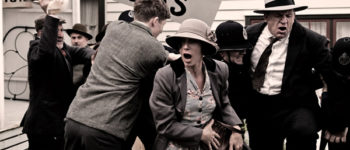1932: Queen Street Riot
April 18, 2019
By AHNZ
 The Slump (aka The Great Depression) reached its most visible and worst point in Auckland on April 14, 1932. Tensions were high as the unemployed marched along Queen Street that day. Fun and games like Cheer Up Week were in the rear-view. Union Leader Jim Edwards organised street demonstrations but this one was getting out of hand. By some accounts, Jim was asked by a senior policeman to calm the crowd down so he clambered onto the plinth of the the clock tower to do so. In the process of doing this, Edwards was felled by a policeman with his baton thus kindling the riot along with the lootings and injuries to follow.
The Slump (aka The Great Depression) reached its most visible and worst point in Auckland on April 14, 1932. Tensions were high as the unemployed marched along Queen Street that day. Fun and games like Cheer Up Week were in the rear-view. Union Leader Jim Edwards organised street demonstrations but this one was getting out of hand. By some accounts, Jim was asked by a senior policeman to calm the crowd down so he clambered onto the plinth of the the clock tower to do so. In the process of doing this, Edwards was felled by a policeman with his baton thus kindling the riot along with the lootings and injuries to follow.
Genesis of Riot
Edwards, now with a very sore head, was a wanted man. In hiding for the next 10 weeks, he moved from safe house to safe house. At one stage he was under the protection of Rev. Scrimgeour and at another stayed in the same house as Elsie Locke who later wrote about the lead-up to the riot…
“On a grey day in April I stood on the pavement..watching for the first time a demonstration of unemployed men…. When the last of the ten thousand had passed me, I was left on the pavement to answer the question these men had silently flung at me: whose side are you on? Whoever you are, and wherever you are going, I am going too, I had answered.’”- Locke, Looking for Answers, Landfall (1958)
The first time I read that it was very exciting because I realised how utterly stupid this was. How uncritical, how unthinking, how gut-level reactionary it was to align with a group while explicitly knowing that you do not know who they are or what they stand for. Locke and 1930s New Zealand had been larger than life, unfathomably out of my league to comprehend, but with these lines I really got it. They were basic, down-regulated, Group Think masses in the throes of mob excitement. Particularly the twenty year old student, Elsie Locke.
 Another young Kiwi woman in her early twenties, Chloe Phillips-Harris, writes of the same experience. In her new book, Fearless (2019) she describes similar conditions but in Egypt, 2012, and between political factions…
Another young Kiwi woman in her early twenties, Chloe Phillips-Harris, writes of the same experience. In her new book, Fearless (2019) she describes similar conditions but in Egypt, 2012, and between political factions…
“The episode taught me a lot about mob mentality and how riots work. Having felt the energy in the square that day, even me with no dog in the fight, so to speak, I’d wanted to protest and march too. It was a violent, powerful, seductive energy, and I can now understand how normal, logical, caring humans can turn into monsters and do violent things if caught up in it. I would like to think that, for me, logic would always win out and that every human owns their actions and won’t fall victim to the mob. But part of me will always understand how riots and the mob mentality can lead rational humans astray.”- p176
Chloe, admittedly, was inured by being a little older and in a foreign country but as we see here she processed her experience very differently to the other writer, Elsie. Her insights show us how the 1932 protests escalated into riot. But it also shows how some young people became radicalised by imprinting onto the rioting times and, in the case of Locke, became life-long Communists.
New Zealand has had eight riots, this was number six and the last one out in public (the next 2 being at prisons.) With the advent of the Welfare State since then there tends to be enough free money and carbohydrates to settling the masses down from trying to effect change by mass protest. But that only means the same resentment energy sublimates and takes other forms.
—
image ref. Life’s A Riot (2008)
image ref. Chloe Phillips-Harris having adventures; CPH blog
 Like Comment Share
Like Comment Share





